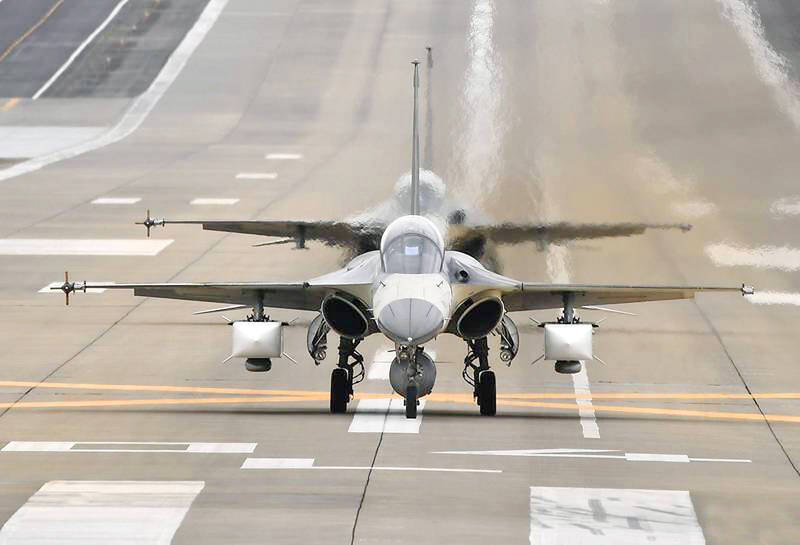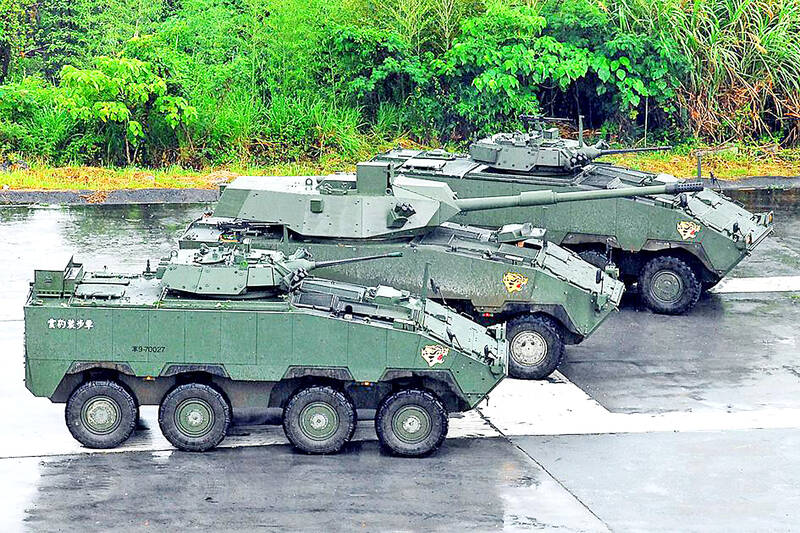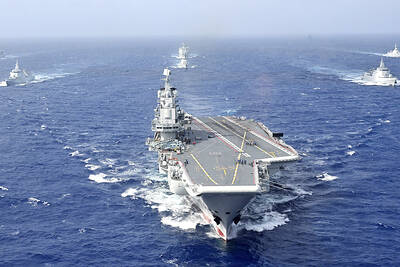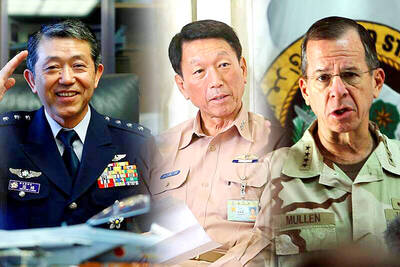The nation is on track to achieve a three-year plan to make 150 Wan Chien air-to-ground cruise missiles by the end of this year, a source familiar with the matter said yesterday.
The Wan Chien, a long-range precision-guided weapon utilized by the AIDC F-CK-1 Indigenous Defense Fighters, carries a payload of cluster munition for attacking troop concentrations and air bases, and has a claimed range of 200km, the source said on condition of anonymity.
According to the publicly listed portion of the Sea-Air Combat Power Improvement Plan, the Wan Chien missile production plan is budgeted at NT$370 million (US$11.82 million) to be implemented from 2022 to this year.

Photo: Taipei Times
That means total production would likely reach 150 missiles as the Chungshan Institute of Science and Technology has reported being able to make 50 missiles a year.
The nation would then have as many as 200 Wan Chien missiles since the Changshan Institute has previously been making the missiles under a general budget.
Additionally, the Ministry of National Defense has listed a NT$501.745 million budget for manufacturing Wan Chien missiles via a contractor, the source said.

Photo courtesy of the Military News Agency
This budget item most likely referred to an improved version of the Wan Chien that has a range of 400km, they said, adding that air force capabilities would get a significant boost if jets were to receive the extended-range missiles.
The 3rd Tactical Fighter Wing in Taichung and the 1st Tactical Fighter Wing in Tainan — the indigenous defense fighter air wings — have tested the missiles in live-fire drills and expressed satisfaction with the system, the source said.
Separately, the army’s Inspector of Armor has certified a locally produced 105mm rifled gun turret for a planned armored fighting vehicle to be based on the CM32, a defense official said on condition of anonymity.
The turret and its mounted gun demonstrated stability, precision and a hit probability superior to all active service armored fighting vehicles, including tanks, during live-fire trials conducted at the Armor Training Command, the official said.
A non-commissioned female officer — the best gunner to take part in the live-fire trials — had fired multiple shells through the same perforation on a target, the official said.
The Inspector of Armor has also given a score indicating satisfactory performance to the D1 and D2 prototypes for the vehicle that would receive the turret, with the exception that the hulls were 30cm taller than requested.
Meanwhile, a program to develop a 105mm-gun-armed wheeled armored fighting vehicle faces an uncertain future, as the army expects to receive M60A3 Patton and M1A2T Abrams battle tanks next year, they said.
The M60A3, though armed with the same gun, is better protected than the proposed wheeled vehicle, while the M1A2T, which sports a 120mm smooth bore gun and heavy composite armor, is markedly superior in both firepower and protection.
The Armaments Bureau and the 202 Arsenal are nevertheless working hard to roll out a complete 105mm-gun-armed vehicle as they believe the nation needs to have an indigenous ground warfare capability, the official said.

A Chinese aircraft carrier group entered Japan’s economic waters over the weekend, before exiting to conduct drills involving fighter jets, the Japanese Ministry of Defense said yesterday. The Liaoning aircraft carrier, two missile destroyers and one fast combat supply ship sailed about 300km southwest of Japan’s easternmost island of Minamitori on Saturday, a ministry statement said. It was the first time a Chinese aircraft carrier had entered that part of Japan’s exclusive economic zone (EEZ), a ministry spokesman said. “We think the Chinese military is trying to improve its operational capability and ability to conduct operations in distant areas,” the spokesman said. China’s growing

Nine retired generals from Taiwan, Japan and the US have been invited to participate in a tabletop exercise hosted by the Taipei School of Economics and Political Science Foundation tomorrow and Wednesday that simulates a potential Chinese invasion of Taiwan in 2030, the foundation said yesterday. The five retired Taiwanese generals would include retired admiral Lee Hsi-min (李喜明), joined by retired US Navy admiral Michael Mullen and former chief of staff of the Japan Self-Defense Forces general Shigeru Iwasaki, it said. The simulation aims to offer strategic insights into regional security and peace in the Taiwan Strait, it added. Foundation chair Huang Huang-hsiung

PUBLIC WARNING: The two students had been tricked into going to Hong Kong for a ‘high-paying’ job, which sent them to a scam center in Cambodia Police warned the public not to trust job advertisements touting high pay abroad following the return of two college students over the weekend who had been trafficked and forced to work at a cyberscam center in Cambodia. The two victims, surnamed Lee (李), 18, and Lin (林), 19, were interviewed by police after landing in Taiwan on Saturday. Taichung’s Chingshui Police Precinct said in a statement yesterday that the two students are good friends, and Lin had suspended her studies after seeing the ad promising good pay to work in Hong Kong. Lee’s grandfather on Thursday reported to police that Lee had sent

BUILDUP: US General Dan Caine said Chinese military maneuvers are not routine exercises, but instead are ‘rehearsals for a forced unification’ with Taiwan China poses an increasingly aggressive threat to the US and deterring Beijing is the Pentagon’s top regional priority amid its rapid military buildup and invasion drills near Taiwan, US Secretary of Defense Pete Hegseth said on Tuesday. “Our pacing threat is communist China,” Hegseth told the US House of Representatives Appropriations Subcommittee on Defense during an oversight hearing with US General Dan Caine, chairman of the Joint Chiefs of Staff. “Beijing is preparing for war in the Indo-Pacific as part of its broader strategy to dominate that region and then the world,” Hegseth said, adding that if it succeeds, it could derail